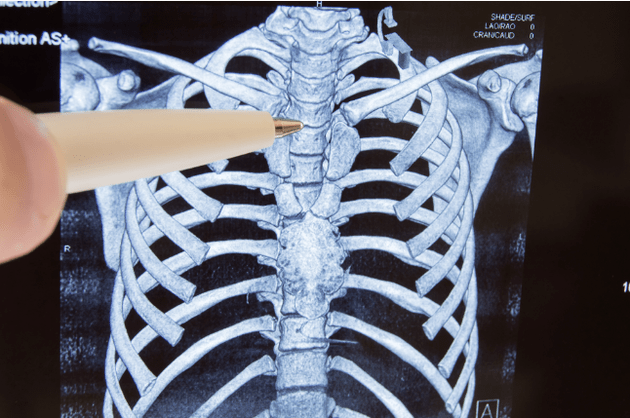Osteochondrosis is a disease of the spine in which intervertebral discs (and later the body of vertebrae, joints and ligaments) lose their ability to function.

The cause of osteochondrosis is currently considered to be factors that affect the spine in human life.Further risk of osteochondrosis develops by interrupting the spinal column injuries and posture.Some patients note the relationship between the disease and hypothermia.
In practice, it is customary to consider
- cervix osteochondrosis,
- The chest osteochondrosis and
- lumbar spine.
Separately, it should be noted that osteochondrosis is common, characterized by damage to several spinal parts.
The most common is the cervix and chest shapes as these spine classes are subject to the highest load.
Symptoms of osteochondrosis
In osteochondrosis, patients describe symptoms such as:
- paroxysmal or shooting pain in the spine affected by osteochondrosis;
- increased pain after physical effort and in the morning;
- Pain can be given to the neck, arm or leg, as well as in the chest;
- Crunch's sensation when you are twisting.
Osteochondrosis is also characterized by neurological symptoms on the affected side:
- violation of partial motions (paresis);
- discomfort in the form of goosebums, tingling (paresthesia);
- During palpation, the voltage of the muscles corresponding to the affected class is determined.
The disease gradually begins and develops, not sharply.
The spine osteochondrosis should be distinguished from coronary heart disease (in the case of coronary heart disease, the occurrence of pain is not related to physical activity, but due to the side factors: cough, prolonged session).
Treatment
The same symptoms may be signs of various diseases and the disease cannot occur according to the textbook.Don't try to treat yourself - consult your doctor.
Osteochondrosis therapy always requires an integrated approach.During the treatment, doctors such as therapists, a rheumatologist, neuropathologist and physiotherapist are the attention of doctors.Treatment of osteochondrosis of the spine depends on localization, dominant symptoms and severity of the disease.
The purpose of conservative therapy is to eliminate the symptoms of pain and to restore normal spine function.
The rational diet of osteochondrosis greatly facilitates the patient's condition and promotes more effective therapy.More information on the nutritional principles of osteochondrosis in our separate article.
Patients are approx.10% is sent for surgical treatment.The absolute indicator of surgical intervention of osteochondrosis is the appearance of nervous system disorders, as it was pinched by the spinal cord itself.
Further indicators for surgical treatment of osteochondrosis are considered as follows:
- a longer regular attack of pain;
- increased mobility and suspicion of spine instability;
- The effectiveness of medication for 3 months;
- Pronounced disorders that prevent the patient's entire life.
Surgical treatment methods
Surgical interventions with minimal trauma:
- Preparation-inzene enzyme preparations are administered to the intervertebral disk after scarring of the seed and scarring the fibrous ring of the plate.
- Punctional Nucleotomy - intervertebral discharge to remove part of the poison.
- Disha Denction - A drug is introduced into the intervertebral disc that blocks the sensitivity of nerve endings.
The remaining methods of surgical treatment of osteochondrosis of the spine are less gentle.They belong to:
- Complete or partial removal of the intervertebral disk or its hernia - this operation is aimed at reducing compression symptoms.
- Prosthetics of intervertebral plates - the main task is to fix the affected spinal segments.
Operational methods to treat osteochondrosis of the spine provide a forecast for complete healing in only 50% of cases.
In addition to timely treatment, life forecasts are almost always favorable, but the prognosis for working can be different due to many factors.
Practices of osteochondrosis
1 Exercise.
Tilt your head forward while pressing your forehead with your woven fingers.Stress your fingers tightly on the back of the head and whiskey - left, to the right.The head offset the pressure of the hands and hands - the pressure of the head.Spend 10 seconds.For every movement.
Exercise 2.
Place the tip of the four fingers on the forehead, gently press the skin with the entire surface of the palm, and with soft adhesion movements for 10-40 seconds.We can do the same stretch in the temple, longitudinal and transverse.The same - on his ear - to stretch it in all directions, especially the lobe.That.It improves blood circulation in areas rich in biologically active points.
Exercise 3.
This type of massage improves blood flow in jugular veins and the nutrition of the brain improves.Sit exactly, the back is straight.Slowly take your head back, helping your hand, pressing your chin back and up.Slowly turn your head a little left and right.Stay in this position for about a minute.10 seconds for kids.
Exercise 4.
This exercise improves the function of the cervix nervous plexus.Sit exactly, the back is straight.Slowly tilt your head forward and try to touch your chest.Place your woven fingers on the back of the head, pressing forward and up, lifting the back of the head.Sit like this for about a minute.You can repeat it after 15 minutes.
5 Exercise.
Raise your shoulder and try to your ear, lower, free, faster - for 15 seconds.Now alternating - one shoulder up and the other down, also 15 seconds.Pull the cervix's spine with your palm.






















